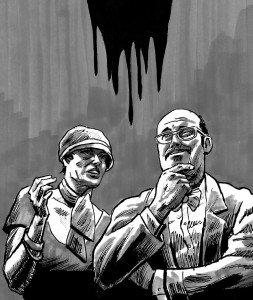From The Unspeakable Oath 18, available for purchase in print and PDF.
Written by Nick Grant,© 2010
A small-town sculptor has started receiving international renown for his depictions of, as one critic puts it, “the unsettling complexities behind rural life.” A touring show of his work has recently come to the investigators’ city and has attracted the attention of occult movers and shakers.
The show itself seems to be anything but the work of an esteemed artist. Sculptures depict the most heinous scenes of human horror, but with strange agricultural undertones. One man strangles another between three tall cornstalks; a robed figure kneels before a grain thresher, holding before the spinning blades a small child; a woman hangs from a tree, dead, in an otherwise stunningly beautiful pastoral scene.
As art connoisseurs and rich dilettantes roam among the pictures, quiet murmurs of shock slowly build to emphatic ravings about the work. Some of the people there mention to the investigators that they’ve been following the artist around the country, and that they can’t seem to get enough of his work, even though they feel a powerful, almost supernatural repulsion to it..
Option 1: His Brother’s Keeper
 The young man should have been an overnight sensation: a novelty forgotten as soon as the highbrows found some new grotesquerie to latch onto. What no one has quite figured out is that it isn’t the art that keeps them coming back. It’s the punch. In some nondescript barn of the Iowan corn fields the artist’s bookish brother developed a drug with insidious psychological effects. Drinking the punch at the gala openings (at which, by contract, the artist will allow no other drink to be offered) makes the event euphoric in the memory of its attendees. Chemical analysis of the punch reveals some surprising compounds, and one or two of those addicted fans might have a notion of what the real draw of the art show is. Side effects include physical dependence on the punch and slow neurological disintegration reminiscent of Alzheimer’s disease. Both of these are of course most intense in those who followed the artist for the longest.
The young man should have been an overnight sensation: a novelty forgotten as soon as the highbrows found some new grotesquerie to latch onto. What no one has quite figured out is that it isn’t the art that keeps them coming back. It’s the punch. In some nondescript barn of the Iowan corn fields the artist’s bookish brother developed a drug with insidious psychological effects. Drinking the punch at the gala openings (at which, by contract, the artist will allow no other drink to be offered) makes the event euphoric in the memory of its attendees. Chemical analysis of the punch reveals some surprising compounds, and one or two of those addicted fans might have a notion of what the real draw of the art show is. Side effects include physical dependence on the punch and slow neurological disintegration reminiscent of Alzheimer’s disease. Both of these are of course most intense in those who followed the artist for the longest.
Option 2: The Pact
The sculptor was just an artist of moderate skill before he found the Cthulhu Mythos. By spending long days and nights in study he was eventually able to learn enough to contact Tsathoggua. The sculptor formed a pact with the Patron of Sorcerers, giving up his soul for fame. This soulless f igure can now create spectacularly fascinating images, but is only fueled by his intense self-loathing and despair. The young man’s entourage sometimes complain about the temperamental artiste he has become; he demands an hour of uninterrupted solitude before each public appearance. Little do they know what goes on in this hour.
Option 3: The Feast
The sculptor is a cultist who worships a lloigor which has been traveling with him. The genius of his sculptures is to induce a mental state akin to the fevered sleep of his patron’s psychic victims. This channels the health of those entranced into the lloigor at a slow rate (one magic point per hour in the presence of the unveiled sculptures, then one hit point per hour if the victim is not removed), without the creature having to expend the energy to ensnare them itself. It leaves a hollow, obsessive feeling in the leeched. The recent success of his pupil means the lloigor has far more energy than it has had in ages. This may manifest in poltergeist-like telekinesis, epidemic nightmares or draconic materializations.
